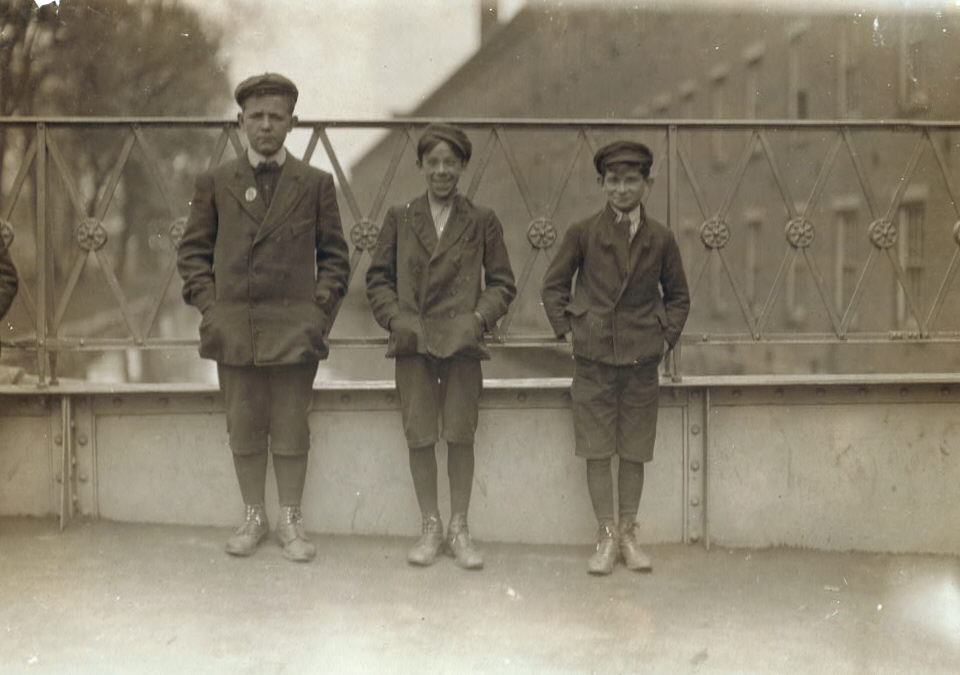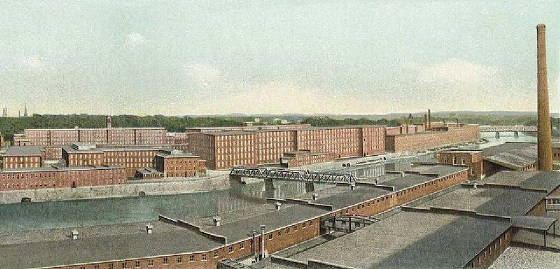
Lewis Hine caption: Boys working in Amoskeag Mills, Manchester, N.H. Smallest boy is Napoleon Cammery, 194 Merrimac St. Been in mill 1 year. Next boy is Jerry Moore, 352 Chestnut St. Martin Markey, 33 State St. Location: Manchester, New Hampshire, May 1909.
I have compiled stories about each of the three boys in this photograph, and included them all in this section. Following the introduction, Martin’s story is first, followed by stories about Jeremiah Moore and Napoleon Camire.
Introduction
The following is from Child Employing Industries; Proceedings of the Sixth Annual Conference, Boston, Massachusetts, January 13-16, 1910, by Henry C. Morrison, State Superintendent of Public Instruction, New Hampshire.
“The New Hampshire child labor law, in its inception, was an educational rather than a labor measure. In the nineties our people woke up to the fact that the percentage of illiteracy had greatly increased in the state during the preceding thirty years. Their attention centered upon this fact; they at once saw that one of the important causes was the employment of children who ought to be in school. It is doubtful if the child labor phase of the situation, as such, was first in the mind of any one, either in the legislature or outside. Their first thought was: these children must be in school; and, second, young children, moreover, ought not to be exploited for industrial purposes.”
“The law enacted in 1901 in substance provides that no child under the age of twelve years shall be employed in any manufacturing establishment or in any mechanical, mercantile or other employment; that no child under the age of fourteen shall be so employed while the public schools are in session; that no child under the age of sixteen shall be so employed unless he can produce a certificate from the local superintendent of schools certifying his ability to read and write legibly simple sentences in the English language, accompanied by an affidavit sworn before that officer that the child is of the age represented; and, further, no minor may be employed who cannot read and write legibly simple sentences in English unless he attends an evening or other school in which such branches are taught. The law gives the state superintendent of schools joint authority with the local school boards in enforcing the law, and authorizes him to employ deputies for that purpose.”
“The distinctive feature of the law is its educational test, both because its enforcement rests upon an educational test primarily, and because the certificate of educational fitness is left by law in the board, or other local authority, can take away this authority from their superintendent and bestow it upon some other person. An exception to this rule is found in the city of Manchester, in which the statute specifically authorizes the city truant officer to issue age and literacy certificates, but his office is at the school department, and his work is under the oversight of the local superintendent of schools.”
“The state has no accurate data available to show the number of children employed in our manufacturing establishments prior to the enactment of the existing law. We know that immediately after its enactment there was a great influx of children into the public schools, so much so that it became necessary to increase school accommodations in nearly all our manufacturing towns. A considerable number of children annually are illegally employed and escape detection. From the information which the department has been able to secure we feel pretty confident that in the state at large the percentage of these children is well within 10 per cent., and we propose to keep on whittling that down.”
“Industrially, our problem is almost entirely with textile manufacturers, and chiefly with the cotton industry. About one-third of our people live in towns whose chief industrial basis is textile work. In dealing with the situation in these towns, both state and local authorities have accomplished vastly more by what might be called a campaign of education among employers than by prosecution. A great majority of the overseers in our mills are disposed to obey the law.”
“So long as there are people who raise children as they do cattle – for the money return — there will be a child labor problem. The National Child Labor Committee has undoubtedly done a great deal of good in this very direction. But it can never hope adequately to cover this ground. It can render its best service, as it is doing, by awakening people to an understanding of the situation and thus securing enactment of progressively more adequate laws.”
“More than by any other one factor is the enforcement of the law made possible by an informed and enlightened public opinion. Many people think they are so far doing God and the country a service in raising a large family of children that they are entitled to lie back and let the children support them as soon as the oldest one can work. We all, no doubt, know men of entirely right lives and generous impulses, and even love for children, who believe that child labor agitation is not only cranky but pernicious. Such men honestly believe it is a good thing for a boy to go to work and earn some money. They do not differentiate as to age, sex and bodily condition, but in general their argument is this: ‘Some of our ablest and most successful business men, and some of our greatest statesmen began that way. Let the child go to work if he wants to.’ You must overcome that attitude of mind before your child labor law will do its work as you want it done, and when you have succeeded in educating these two classes of people and others so that they will see the iniquity and enormity of the industrial exploitation of little children, then there will not be very much need of anti-child labor laws. That is what your National Child Labor Committee is doing and is the direction in which it can do its best work.”
**************************
The Amoskeag Manufacturing Company was established in Manchester in the 1830s. The city of Manchester was designed and built by the owners of the mill. During the Civil War, cotton was scarce, so the factory made muskets, but they returned to producing cotton cloth after the war. In the early 1900s, it was the largest textile manufacturer in the world, with over 17,000 workers. The first workers came from farms in New Hampshire, but as the company expanded, they recruited immigrants from French Canada, Greece and Poland.
When cheap labor provided stiff competition from southern textile mills, Amoskeag increased hours and lowered wages, resulting in a strike in 1922, closing the mill for nine months. When workers returned, they had won no concessions. In the 1930s, the Depression caused the company great hardship, and the mill finally closed at the end of 1935. The huge mill complex is now the home of many small industries, offices, the Millyard Museum, and even a childcare center.
Lewis Hine took about 40 photos at the Amoskeag Mill between May 21 and May 26, 1909. Most of the children were not identified in the captions. The photo above attracted me right away. The boys are well dressed, and all have their hands in their coat pockets. They appear comfortable and confident, as they stand on the bridge over the Merrimac River, which appears in the above photo of the mill.

Here are links to the three stories, in the order that I have posted them. Each story links to the next one.